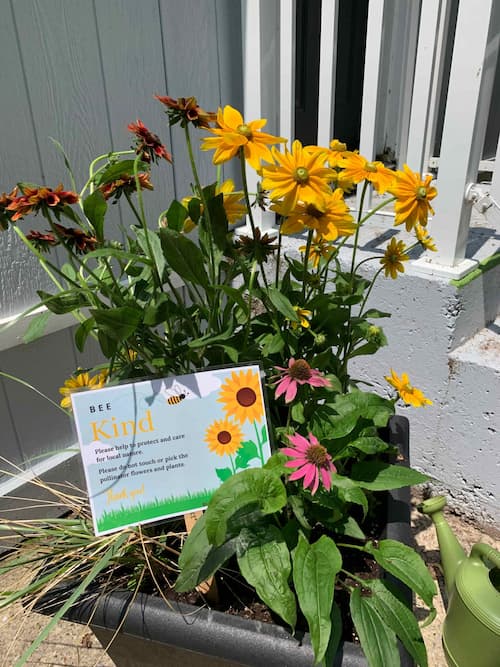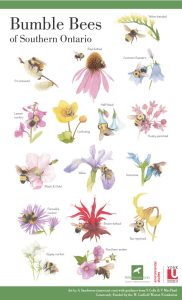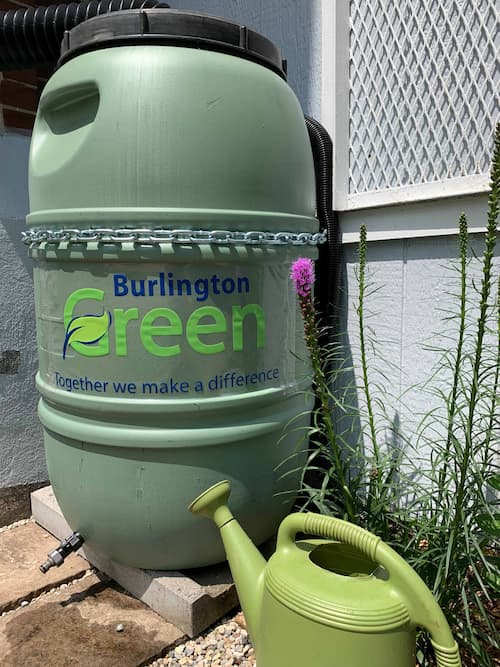Bee a friend to pollinators by learning about what they do and how you can help!
What is a pollinator?
A pollinator is anything that helps plants create new seeds by carrying pollen from one flower to another flower of the same species.
Who are the pollinators?
Bees, birds, bats, butterflies, moths, flies, beetles, wasps, and small mammals.
Why are pollinators important?
Globally nearly 90 percent of all wild flowering plants depend on animal/insect pollination.
What do pollinators need?
- Areas with diverse flowering plants, from spring to fall, with accessible nectar and pollen
- Plants or nesting areas to lay their eggs
- Patches of bare ground to burrow and build their nests
- A diverse array of plant and landscape features such as rocks, dead wood, dead stems, leaves, and mud that support various habitat and nesting needs
Did you know…
- The Ruby-throated Hummingbird is the only common species in Ontario.
- Monarch caterpillars need milkweed plants to grow and develop into butterflies.
- Every third mouthful of food we eat is produced by bees pollinating crops.
Learn about native bees of Ontario here, and check out this beautiful Southern Ontario bees poster.
Take Action Today! Help Green Up Burlington, supporting local pollinators here.
And discover some helpful eco-alternatives to lawns here.
Some of the native pollinator plants in our garden are as follows:
Common Name | Latin Name | Did You Know… | Aster Smooth Blue | Symphyotrichum laeve | Aster Smooth Blue is a host plant for the Silvery Checkerspot and Pearl Crescent butterflies. |
|---|---|---|
Bee Balm | Monarda | Bee Balm is a member of the mint family (Lamiaceae). Its foliage has a strong aroma and is sometimes used in herbal teas, salads and as garnishes. The flowers are also edible. |
Big Blue Stem | Andropogon gerardii | Big Bluestem is the tallest of the North American prairie grasses, reaching heights of 10ft in optimum conditions. |
Black-Eyed Susan | Rudbeckia hirta | Black-eyed Susans are pioneer plants; meaning that they are the first plants to grow in an area damaged by fire or other natural disasters. |
Blazing Star | Liatris Spicata | Blazing Star was used by Indigenous people in North America for several medicinal purposes. The roots were ground and used as a pain reliever for headache, arthritis, and earaches. |
Common Milkweed | Asclepias syriaca | Milkweeds are named for their milky latex, which is found in their stems, leaves, and pods and make them unpalatable to many animals. |
Coneflower | Echinacea | The Latin name of the genus coneflowers is “Echinacea”. It originates from the Latin word “echinos” which means “sea urchin”. The name refers to the spiny cone of the flower head. |
Lanceleaf Coreopsis | Coreopsis lanceolata | Although native to Ontario, Lanceleaf Coreopsis is officially listed as an “Invasive Alien Species” in Japan where it has become a serious pest species. |
Little Bluestem (Grass) | Schizachyrium scoparium | Little Bluestem is a larval host to over a dozen insects including skipper butterflies and grasshoppers. |
Marram Grass | Ammophila | Marram grass was once harvested and weaved into mats for barn roofs, nets for fishing and even shoes. |
Conserve water with a rain barrel!
A rain barrel is a system that collects and stores rainwater from your roof that would otherwise be lost to runoff and diverted into storm drains and streams.
What are the benefits of having a rain barrel?
Lawn and garden watering make up nearly 40% of household water use during the summer. Did you know that having a rain barrel could save the average homeowner about 1,300 gallons of water during peak summer months?
Water collected in the rain barrel could be used to water your lawn and garden, to wash your car, or to top up a swimming pool. Not only does this help save the environment, but it saves you money and energy!
Where can I get a rain barrel?
Check out rainbarrel.ca for more information on purchasing a rain barrel for your home. They offer free home delivery to Burlington and Oakville.
Starting in 2012, BurlingtonGreen led various dune restoration projects at the Burlington beach where hundreds of volunteers joined us to plant thousands of native grasses, plants, shrubs and trees:
Common Name | Latin Name | Did You Know… | White Oak ( Tree) | Quercus alba | In peak years, large White Oak trees can produce 10,000 acorns. |
|---|---|---|
Bur Oak (Tree) | Quercus macrocarpa | Bur Oak is the most fire-resistant of the oaks and is consequently common in savannas and prairie groves. It is also one of the most cold-tolerant oaks. |
Trembling Aspen (Tree) | Populus tremuloides | Trembling Aspen can form expansive colonies by sending up new stems as an old stem dies. One colony in Utah is estimated to be over 80,000 years old. |
Chokecherry (Shrub) | Prunus virginiana | The Chokecherry tree flowers in late spring before producing edible, sour fruits. The fruits are edible and used to make wine, syrup and jams. |
Heart-leaved Willow ( Shrub) | Salix cordata | The Latin name “cordata” means heart-shaped, referring to the somewhat heart-shaped base of the leaves. |
American Beach Grass (Marram Grass) | Ammophila breviligulata | Marram grass was once harvested and weaved into mats for barn roofs, nets for fishing and even shoes. |
Canada Wild Rye (Grass) | Elymus canadensis | Canada Wild Rye is also called “nodding wild rye” because the seed heads droop gracefully downward as they mature. |
Switchgrass | Panicum virgatum | The species name virgatum is from the Latin meaning ‘wand-like’ or ‘twiggy in growth’, referring to the tall stems. |
Indian Grass | Sorghastrum nutans | Caterpillars and grasshoppers that eat the grass blades from this plant become a food source for birds. |
Sand Dropseed | Sporobolus cryptandrus | Native bunchgrasses, like Sand Dropseed, provide nesting ‘substances’ for native bees to use. This means that native bees are able to nest inside, underneath, or use substances from the plant to build their nests. |
Canada Anemone (Wildflower) | Anemone canadensis | Instead of producing a thimble-like flower head with fluffy seeds like many other Anemone species, this species produces a bur-like cluster of flattened seeds with long beaks. |
Thimbleweed (Wildflower) | Anemone virginiana | The central cone of the flower, looking something like a green thimble, gives the plant its name, Thimbleweed. |
Common Milkweed | Asclepias syriaca | Milkweeds are named for their milky latex, which is found in their stems, leaves, and pods and make them unpalatable to many animals. |
Cocklebur (plant) | Xanthium strumarium | Cockleburs are nature’s Velcro; the idea for Velcro came from a plant very similar to cocklebur. Lots of people look to the natural world for ideas for new innovations – this is called biomimetics or bio-inspired technology. |
Grey Goldenrod (plant) | Solidago normalis | Grey Goldenrod is one of Ontario’s lowest growing goldenrods, usually staying under 2ft. |
Grass-leaved Goldenrod (plant) | Euthamia graminifolia | Grass-leaved Goldenrod is technically not a Goldenrod but it looks and acts very similar. It is a bumblebee and native bee magnet! |
Common Evening Primrose (plant) | Oenothera biennis | Common evening-primrose has long been cultivated for its seeds which are the source of evening-primrose oil. This oil is used in complementary medicine to decrease premenstrual syndrome and to treat skin disorders such as dermatitis and psoriasis. |
Discover more of BG’s Nature-Friendly Burlington resources and opportunities here.
BurlingtonGreen graciously thanks Home Depot Burlington and Marilu’s Market for their product support for the garden. And we are vert grateful to the following Nature-Friendly Burlington program supporters:





